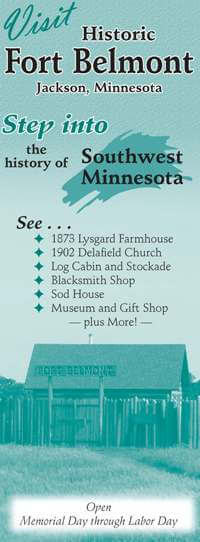For centuries, many indigenous peoples called this area home, including the Cheyenne, Ioway, and Dakota tribes. In 1851, the Treaty of Traverse des Sioux opened the region to white settlement in exchange for payments from the government. The first settlers in what is now Jackson County - William, George, and Charles Wood - established a trading post near the Des Moines River in July 1856 and named the town “Springfield.” Forty additional settlers soon followed.
A brutal winter complete with bitter cold, deep snow, and violent storms battered the area. To survive these harsh conditions, some Native Americans resorted to begging and even raiding new settlements for scarce food resources. Tensions rose between the two groups, culminating in the Spirit Lake Massacre in March 1857 which saw about 40 settlers around Okoboji and Spirit Lake killed at the hands of Inkpaduta and his band. The band then traveled northward, setting its sights on Springfield. On March 26, they attacked, killing seven settlers and wounding three others. Terrified of a possible second attack, the beleaguered survivors abandoned the area.
Two months later, the Minnesota State Legislature organized the area into a county, naming it after Saint Paul merchant Henry Jackson. The temporary county seat was located at the townsite of Springfield, now renamed Jackson. The area was still depopulated, however, and resettlement was slow due to continued hostility. In August 1862, the Dakota, angry at late payments from the government, skirmished with settlers; one such skirmish compelled some Dakota leaders to attack government buildings in the Minnesota River, starting the US-Dakota War. By August 24, the effects of the war had reached Jackson County. Warriors raided a community of Norwegian immigrants in Belmont Township north of Jackson, killing thirteen and wounding three. As in 1857, the remaining settlers fled, leaving Jackson County depopulated once more.
After the Civil War, resettlement in Jackson County began again. A stockade was built on the east side of the river, encouraging further immigration. These immigrants primarily came from Northern and Central Europe. They built their homes from native timber and prairie sod. Life remained difficult; there were no wagon roads, no bridges, no churches, and only one school that served the community. The threat of attack remained, and the region was susceptible to numerous disasters including prairie fire, severe blizzards, crop failures, and plagues of grasshoppers. Despite such hardship, these hardy, courageous pioneers survived and helped establish the prosperous agricultural and industrial community that Jackson is today.
Historical Sites



